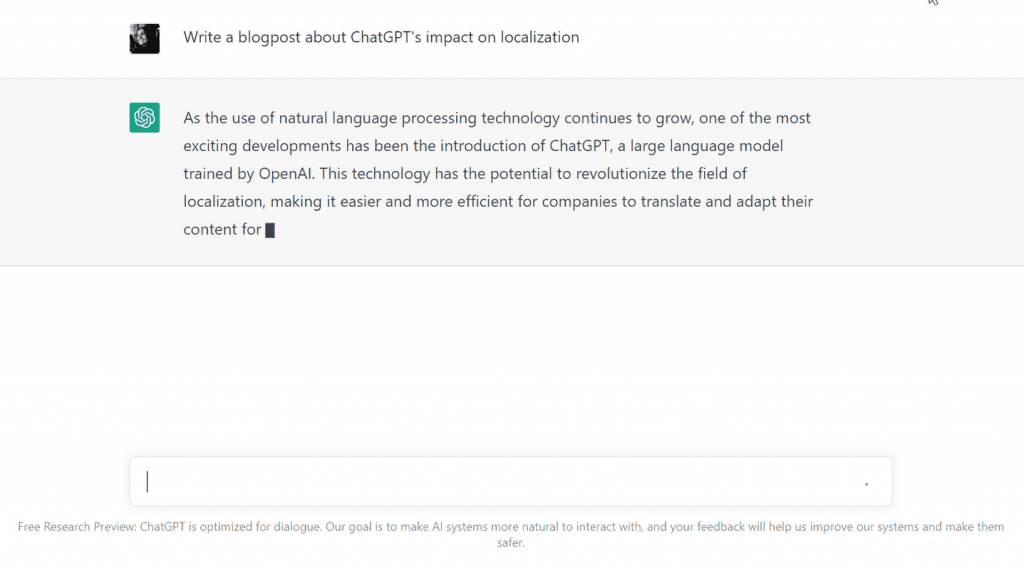Corinne Sharabi
Corinne is the Social Media and Content Lead at BLEND. She is dedicated to keeping global business professionals up to date on all things localization, translation, language and culture.

If you’re in the localization industry, chances are you’ve heard about OpenAI and their ChatGPT. But what is ChatGPT and how will it impact the localization industry?
First, let’s talk about what ChatGPT is. ChatGPT is an AI language model developed by OpenAI that has the ability to generate human-like text responses to any given input. In other words, it’s like having a conversation with a machine. This technology has the potential to revolutionize the way we communicate and exchange information.
ChatGPT’s translation capabilities are impressive, offering accurate and coherent translations for a wide range of languages. It excels at common phrases, sentences, and general content, making it a valuable tool for everyday translation needs. However, its performance can vary depending on the complexity of the content and the specific language pair.
While ChatGPT is a powerful, language translation model, it may not match the precision and nuance of professional human translators for highly specialized or culturally sensitive materials. Overall, ChatGPT is a reliable and efficient option for many translation tasks, particularly when speed and accessibility are essential, but it may benefit from human oversight in certain contexts.
Well, for one, it has the potential to make the translation process faster and more efficient. ChatGPT can quickly generate multiple translation options for a given text, which can save time and effort for human translators. This means that they can focus on reviewing and refining the translations rather than spending time on the initial translation.
Another potential impact of ChatGPT is that it could potentially reduce the need for human translators in some cases. As the technology improves, ChatGPT may be able to handle simple translation tasks without the need for human intervention. This could lead to cost savings for companies looking to localize their content.

OpenAI’s ChatGPT writes human-like text responses when you give it a prompt
However, it’s important to note that ChatGPT is not intended to replace human translators. It’s simply a tool that can assist them in their work. Human translators still have a critical role to play in the localization industry, particularly when it comes to translating complex or specialized content.
Large Language Models (LLMs) and traditional Machine Translation (MT) systems serve as pivotal tools in the language industry. LLMs have redefined translation by integrating deep learning techniques and vast datasets, enabling them to comprehend and generate human-like text. In contrast, traditional MT relies on rules-based or statistical methods to translate text between languages.
While both have their merits, LLMs offer advantages such as contextual understanding, natural language generation, and adaptability to various languages and domains. These advancements have positioned LLMs as valuable assets for enhancing translation quality, bridging language gaps, and expanding the capabilities of MT, making them essential in today’s multilingual and globalized world.
The translation market has been undergoing a significant transformation with the introduction and advancement of Artificial Intelligence (AI) and other Large Language Models (LLMs) like ChatGPT. These technologies are revolutionizing the language services industry and the way content is translated, providing benefits such as automated translation, cost reduction, and faster turnaround times. In this article, we will delve into how ChatGPT and LLMs are affecting the translation market.
One of the most notable impacts of ChatGPT and LLMs on the translation market is the advent of automated machine translation engines. These AI-powered models have the capability to automatically translate text from one language to another with remarkable accuracy. This automation of language services has several implications for the translation industry:
However, it’s essential to note that while automated translation offers many advantages, it may not be suitable for all types cultural nuances of content. Highly specialized or culturally nuanced content often requires human expertise and understanding to ensure accurate and culturally sensitive translations.
The integration of ChatGPT and LLMs into the translation process has brought about notable cost reductions for businesses:
It’s important to emphasize that while cost reduction is a significant benefit of AI-driven translation, businesses must still prioritize the overall quality of translations. Accuracy and cultural sensitivity should not be compromised for the sake of cost savings.
In today’s fast-paced global market, speed is of the essence. ChatGPT and LLMs are accelerating translation processes:
However, while faster turnaround times are advantageous, businesses must also prioritize translation quality. Rushed translations may sacrifice accuracy and effectiveness, potentially harming a company’s reputation, future, or customer relationships.
In the realm of localization, ChatGPT and Large Language Models (LLMs) have emerged as powerful tools, transforming the way content is translated and adapted for diverse markets and users. These AI-driven models offer significant advantages in content translation, text adaptation, content generation, and quality assurance within the localization workflow.
Content translation is the foundational step in any localization process. ChatGPT and LLMs are instrumental in automating and enhancing this critical stage:
Localization goes beyond mere translation; it involves adapting content to suit the cultural, linguistic, and contextual knowledge nuances of the target audience. ChatGPT and LLMs play a crucial role in this text adaptation phase:
Ensuring the quality of localized content is paramount in localization workflows. ChatGPT and LLMs contribute significantly to quality assurance:
The future of localization is intrinsically linked to the rapid advancements of Large Language Models (LLMs). These powerful AI tools will continue to play a pivotal role in automating and improving translation and adaptation processes. LLMs hold the promise of even greater accuracy, efficiency, and cultural sensitivity, enabling businesses to seamlessly connect with global audiences. As LLM technology evolves, we can anticipate more accessible, scalable, and customized localization solutions, making it an indispensable component of global business strategies in the years to come.
Overall, ChatGPT has the potential to greatly impact the localization industry. It can make the translation process faster and more efficient, and it could potentially reduce the need for human translators in some cases. However, it’s important to remember that human translators still have an important role to play in the industry.
So, what do you think? Are you excited about the potential of ChatGPT in the localization machine translation industry?
Oh, and by the way…this blog post was created and written entirely by ChatGPT (with professional editing from our team, of course) 😉
Related:
What our customers are saying